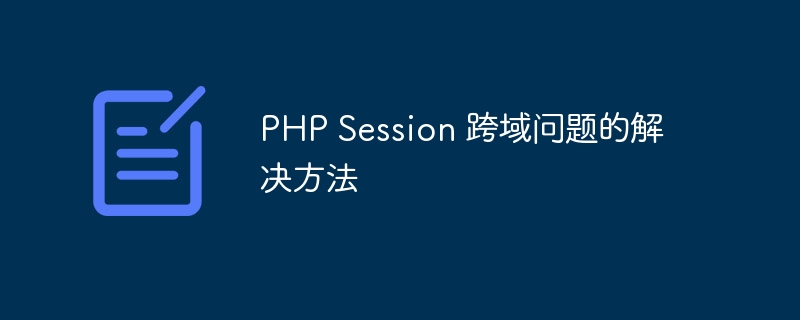Solution to PHP Session cross-domain problem

Solution to PHP Session cross-domain problem
In development where the front and back ends are separated, cross-domain requests have become the norm. When dealing with cross-domain issues, we usually involve the use and management of sessions. However, due to browser origin policy restrictions, sessions cannot be shared by default across domains. In order to solve this problem, we need to use some techniques and methods to achieve cross-domain sharing of sessions.
1. Use cookies to share sessions across domains
The most common solution is to use cookies to share sessions across domains. Since cookies are not restricted by the same-origin policy, session information can be transferred and shared between different domain names.
The specific steps are as follows:
- Set the session on the server side, such as:
session_start(); $_SESSION['user'] = 'example';
- Store the session identification information in the cookie, For example:
setcookie(session_name(), session_id(), time() + 60*60*24*30, '/', 'www.example.com', false, true);
Among them, www.example.com is the domain name of the current server and needs to be modified according to the actual situation.
- In the client of cross-domain request, send a request with cookie, such as:
fetch('http://www.example.com/api', {
credentials: 'include',
})Among them, credentials: 'include' Use This tells the browser to send credentials, including cookies, to the server.
- The server parses the cookie and resets the session, such as:
session_id($_COOKIE[session_name()]);
session_start();
if(isset($_SESSION['user'])){
// session 跨域共享成功
}else{
// session 跨域共享失败
}2. Use token to share the session across domains
Another solution Token is used to achieve cross-domain sharing of sessions. The specific steps are as follows:
- When logging in, a token is generated and stored in the database, associated with the user, such as:
$token = bin2hex(random_bytes(16)); // 将 token 存储到数据库中 // 返回 token 给客户端
- In The client stores the token in local localStorage or sessionStorage.
- When making a cross-domain request, send the token to the server as a parameter or in the request header.
- The server parses the token, verifies the validity of the token by querying the database, and performs corresponding session settings and management.
It should be noted that in order to ensure security, the token needs to set a validity period and be refreshed within a certain period of time. On the server side, expired tokens need to be cleared regularly.
Summary:
The above are two common methods to solve PHP Session cross-domain problems. You can choose a suitable solution according to your actual situation. Whether using cookies or tokens, corresponding processing needs to be performed on the server side to achieve cross-domain sharing of sessions. At the same time, in order to ensure security, we also need to take some measures to protect the security of session data.
The above is the detailed content of Solution to PHP Session cross-domain problem. For more information, please follow other related articles on the PHP Chinese website!

Hot AI Tools

Undresser.AI Undress
AI-powered app for creating realistic nude photos

AI Clothes Remover
Online AI tool for removing clothes from photos.

Undress AI Tool
Undress images for free

Clothoff.io
AI clothes remover

AI Hentai Generator
Generate AI Hentai for free.

Hot Article

Hot Tools

Notepad++7.3.1
Easy-to-use and free code editor

SublimeText3 Chinese version
Chinese version, very easy to use

Zend Studio 13.0.1
Powerful PHP integrated development environment

Dreamweaver CS6
Visual web development tools

SublimeText3 Mac version
God-level code editing software (SublimeText3)

Hot Topics
 1377
1377
 52
52
 PHP 8.4 Installation and Upgrade guide for Ubuntu and Debian
Dec 24, 2024 pm 04:42 PM
PHP 8.4 Installation and Upgrade guide for Ubuntu and Debian
Dec 24, 2024 pm 04:42 PM
PHP 8.4 brings several new features, security improvements, and performance improvements with healthy amounts of feature deprecations and removals. This guide explains how to install PHP 8.4 or upgrade to PHP 8.4 on Ubuntu, Debian, or their derivati
 CakePHP Date and Time
Sep 10, 2024 pm 05:27 PM
CakePHP Date and Time
Sep 10, 2024 pm 05:27 PM
To work with date and time in cakephp4, we are going to make use of the available FrozenTime class.
 Discuss CakePHP
Sep 10, 2024 pm 05:28 PM
Discuss CakePHP
Sep 10, 2024 pm 05:28 PM
CakePHP is an open-source framework for PHP. It is intended to make developing, deploying and maintaining applications much easier. CakePHP is based on a MVC-like architecture that is both powerful and easy to grasp. Models, Views, and Controllers gu
 CakePHP File upload
Sep 10, 2024 pm 05:27 PM
CakePHP File upload
Sep 10, 2024 pm 05:27 PM
To work on file upload we are going to use the form helper. Here, is an example for file upload.
 CakePHP Creating Validators
Sep 10, 2024 pm 05:26 PM
CakePHP Creating Validators
Sep 10, 2024 pm 05:26 PM
Validator can be created by adding the following two lines in the controller.
 How To Set Up Visual Studio Code (VS Code) for PHP Development
Dec 20, 2024 am 11:31 AM
How To Set Up Visual Studio Code (VS Code) for PHP Development
Dec 20, 2024 am 11:31 AM
Visual Studio Code, also known as VS Code, is a free source code editor — or integrated development environment (IDE) — available for all major operating systems. With a large collection of extensions for many programming languages, VS Code can be c
 CakePHP Quick Guide
Sep 10, 2024 pm 05:27 PM
CakePHP Quick Guide
Sep 10, 2024 pm 05:27 PM
CakePHP is an open source MVC framework. It makes developing, deploying and maintaining applications much easier. CakePHP has a number of libraries to reduce the overload of most common tasks.
 How do you parse and process HTML/XML in PHP?
Feb 07, 2025 am 11:57 AM
How do you parse and process HTML/XML in PHP?
Feb 07, 2025 am 11:57 AM
This tutorial demonstrates how to efficiently process XML documents using PHP. XML (eXtensible Markup Language) is a versatile text-based markup language designed for both human readability and machine parsing. It's commonly used for data storage an




